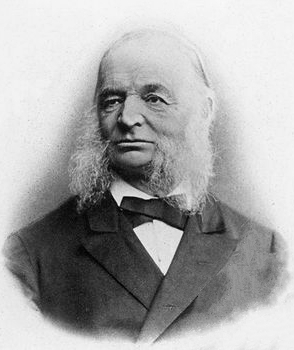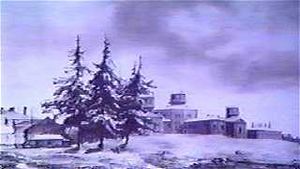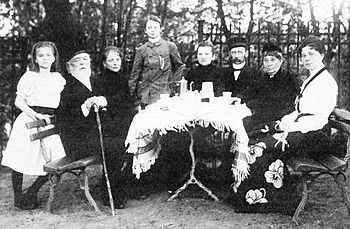Otto Wilhelm von Struve facts for kids
Otto Wilhelm von Struve (born May 7, 1819 – died April 14, 1905) was a famous Russian astronomer. He came from a Baltic German family. In Russian, his name is often written as Otto Vasil'evich Struve.
Otto Wilhelm von Struve and his father, Friedrich Georg Wilhelm von Struve, were very important astronomers in the 1800s. Otto led the Pulkovo Observatory from 1862 to 1889. He was also a top member of the Russian Academy of Sciences.
Contents
Early Life and Education
Otto Struve was born in 1819 in Dorpat (Tartu), which was part of the Russian Empire back then. He was one of many children of Friedrich Georg Wilhelm von Struve.
Otto finished high school at just 15 years old. He was a bit too young for university rules. But he was still allowed to attend the Imperial University of Dorpat. He finished his studies by age 20. While studying, he helped his father at the Dorpat Observatory.
In 1839, he graduated and moved to the new Pulkovo Observatory. There, he became his father's assistant right away. He earned a Master of Astronomy degree in 1841. In 1842, he visited Lipetsk to watch a solar eclipse. He got his PhD in 1843. That same year, Otto officially became a Russian citizen.
Amazing Discoveries and Work
From 1843 to 1844, Struve helped measure the longitude between different cities. These cities included Altona, Greenwich, and Pulkovo. They used a new method that involved moving special clocks called chronometers. This new way of measuring longitude was then used in Russia. From 1844, all longitude measurements started from the Pulkovo Observatory.
In 1844, Struve spent a lot of time studying the Sun. He figured out how fast and in what direction the Sun moves. He found its speed was about 7.3 kilometers per second. Even though later measurements were different, Struve was correct that the Sun moves slower than other stars.
In 1865, he found NGC 8, which is a double star in the Pegasus constellation. Just two days later, he discovered the spiral galaxy NGC 9 in the Andromeda constellation. Struve also looked closely at the constellation of Cassiopeia. He found many double stars there. He used his initials in Greek letters, OΣ and OΣΣ, to label them.
Struve continued his father's important work. They created famous Pulkovo star catalogues. These lists included thousands of double stars. They used a powerful 15-inch telescope for their observations.
Between 1816 and 1852, the observatory finished a huge survey. This was the Struve Geodetic Arc. It was a long chain of measurement points. It stretched over 2,820 kilometers. It went from Norway all the way to the Black Sea. The goal was to find the exact size and shape of the Earth. This arc is now a World Heritage Site.
In 1851, while watching a solar eclipse, Struve made an important conclusion. He realized that the solar corona (the Sun's outer atmosphere) and protuberances (flames shooting from the Sun) were actually part of the Sun. Most astronomers at the time thought they were just optical illusions. Later, in 1860, he suggested that solar protuberances and flares were closely connected.
Struve also observed the moons of Uranus (Ariel and Umbriel) in 1851. He also studied the moons of Neptune. He measured the rings of Saturn and helped discover the dark inner ring of Saturn.
In 1861, he supported the ideas of William Herschel. These ideas suggested that stars form from clouds of gas and dust in space. In 1872, Struve helped set up a new observatory in Tashkent. This southern location had clear skies, which was great for observations.
In 1874, he planned several trips to watch Venus pass in front of the Sun. These trips went to places like eastern Asia, Caucasus, Persia, and Egypt. In 1887, he sent groups across Russia to observe a solar eclipse. He even joined some of these expeditions himself.
In 1885, a huge 30-inch refracting telescope was installed at Pulkovo. At that time, it was the largest in the world.
Leading the Observatory

Around 1845, Otto's father started to step back from managing the Pulkovo Observatory. He wanted to focus more on his own research. So, Otto took on most of the management duties. This became even more true in 1858 when his father became very ill.
When his father retired in 1862, Otto officially became the director. He held this important job for 27 years, until 1889.
For most of these years, the main language used at the Pulkovo Observatory was German. This was because many of the staff members were from other countries. Struve knew some Russian and used it whenever he could.
Trip to the United States
Otto was the first scientist from the Struve family to visit the United States. He traveled there in 1879, visiting cities like New York, Chicago, and San Francisco. One reason for his visit was to order special lenses from Alvan Clark & Sons. These lenses were for the new 30-inch telescope at Pulkovo.
His visit was also part of a long-term partnership between Russia and the US in astronomy. Many American astronomers visited Pulkovo to make observations. They also shared data with Russian scientists through mail. Thanks to Struve, two American astronomers, Simon Newcomb and Asaph Hall, became special foreign members of the Russian Academy of Sciences.
Family and Later Years
Otto Struve was married twice. His first wife was Emilie Dyrssen (1823–1868). They had four sons and two daughters who grew up. After she passed away, Struve married Emma Jankowsky (1839–1902). They had another daughter together.
Two of his younger sons, Hermann Struve and Ludwig Struve, followed in the family's footsteps. They both became well-known astronomers. His older sons chose different paths. One worked in finance, and another became a geologist.
After retiring in 1889, Otto Wilhelm Struve mostly stayed in St. Petersburg. He spent his time writing about his observations and keeping in touch with other scientists. He sometimes visited Switzerland and Italy. In 1895, he became ill during a trip to Germany. He stayed there and passed away in 1905 in Karlsruhe.
Awards and Recognition
Struve received the Gold Medal of the Royal Astronomical Society in 1850. This was for his work on how the solar system moves. He was also a member of the Royal Swedish Academy of Sciences.
From 1852 to 1889, he was a member of the Russian Academy of Sciences. He became a full academician in 1856. In 1874, he became a foreign member of the Royal Netherlands Academy of Arts and Sciences.
The asteroid 768 Struveana was named to honor Otto Wilhelm, Friedrich Georg Wilhelm, and Karl Hermann Struve. A crater on the Moon was named for three astronomers from the Struve family: Friedrich Georg Wilhelm, Otto Wilhelm, and Otto. The Struve Geodetic Arc was added to the World Heritage List in 2005.
See also
- History of the metre
- Seconds pendulum




